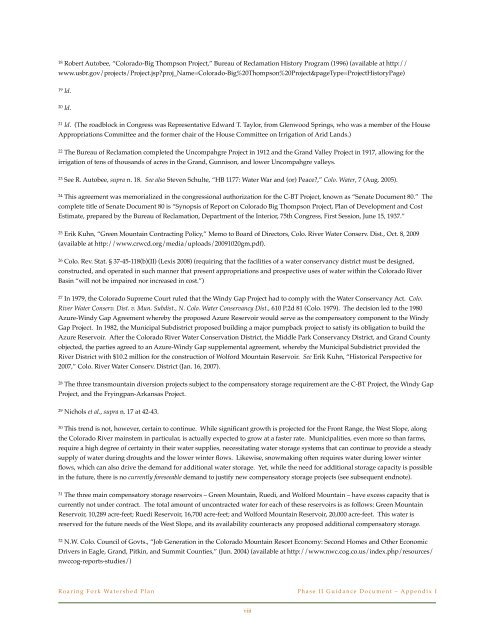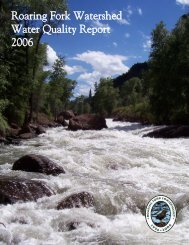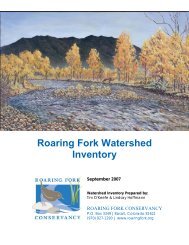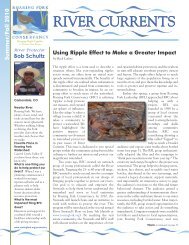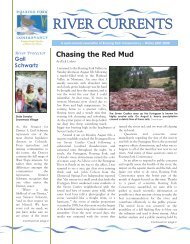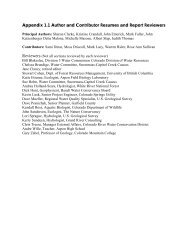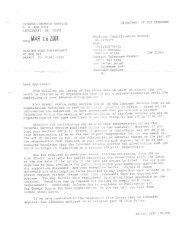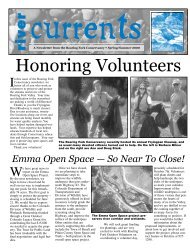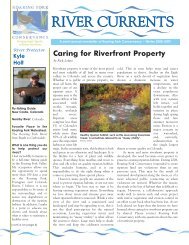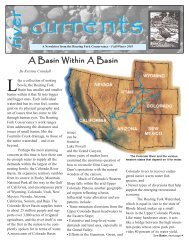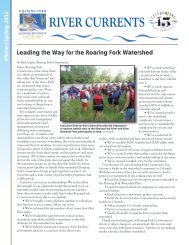The Past, Present, and Future of Transmountain Diversion Projects
The Past, Present, and Future of Transmountain Diversion Projects
The Past, Present, and Future of Transmountain Diversion Projects
Create successful ePaper yourself
Turn your PDF publications into a flip-book with our unique Google optimized e-Paper software.
18Robert Autobee, “Colorado-Big Thompson Project,” Bureau <strong>of</strong> Reclamation History Program (1996) (available at http://www.usbr.gov/projects/Project.jsp?proj_Name=Colorado-Big%20Thompson%20Project&pageType=ProjectHistoryPage)19Id.20Id.21Id. (<strong>The</strong> roadblock in Congress was Representative Edward T. Taylor, from Glenwood Springs, who was a member <strong>of</strong> the HouseAppropriations Committee <strong>and</strong> the former chair <strong>of</strong> the House Committee on Irrigation <strong>of</strong> Arid L<strong>and</strong>s.)22<strong>The</strong> Bureau <strong>of</strong> Reclamation completed the Uncompahgre Project in 1912 <strong>and</strong> the Gr<strong>and</strong> Valley Project in 1917, allowing for theirrigation <strong>of</strong> tens <strong>of</strong> thous<strong>and</strong>s <strong>of</strong> acres in the Gr<strong>and</strong>, Gunnison, <strong>and</strong> lower Uncompahgre valleys.23See R. Autobee, supra n. 18. See also Steven Schulte, “HB 1177: Water War <strong>and</strong> (or) Peace?,” Colo. Water, 7 (Aug. 2005).24This agreement was memorialized in the congressional authorization for the C-BT Project, known as “Senate Document 80.” <strong>The</strong>complete title <strong>of</strong> Senate Document 80 is “Synopsis <strong>of</strong> Report on Colorado Big Thompson Project, Plan <strong>of</strong> Development <strong>and</strong> CostEstimate, prepared by the Bureau <strong>of</strong> Reclamation, Department <strong>of</strong> the Interior, 75th Congress, First Session, June 15, 1937.”25Erik Kuhn, “Green Mountain Contracting Policy,” Memo to Board <strong>of</strong> Directors, Colo. River Water Conserv. Dist., Oct. 8, 2009(available at http://www.crwcd.org/media/uploads/20091020gm.pdf).26Colo. Rev. Stat. § 37-45-118(b)(II) (Lexis 2008) (requiring that the facilities <strong>of</strong> a water conservancy district must be designed,constructed, <strong>and</strong> operated in such manner that present appropriations <strong>and</strong> prospective uses <strong>of</strong> water within the Colorado RiverBasin “will not be impaired nor increased in cost.”)27In 1979, the Colorado Supreme Court ruled that the Windy Gap Project had to comply with the Water Conservancy Act. Colo.River Water Conserv. Dist. v. Mun. Subdist., N. Colo. Water Conservancy Dist., 610 P.2d 81 (Colo. 1979). <strong>The</strong> decision led to the 1980Azure-Windy Gap Agreement whereby the proposed Azure Reservoir would serve as the compensatory component to the WindyGap Project. In 1982, the Municipal Subdistrict proposed building a major pumpback project to satisfy its obligation to build theAzure Reservoir. After the Colorado River Water Conservation District, the Middle Park Conservancy District, <strong>and</strong> Gr<strong>and</strong> Countyobjected, the parties agreed to an Azure-Windy Gap supplemental agreement, whereby the Municipal Subdistrict provided theRiver District with $10.2 million for the construction <strong>of</strong> Wolford Mountain Reservoir. See Erik Kuhn, “Historical Perspective for2007,” Colo. River Water Conserv. District (Jan. 16, 2007).28<strong>The</strong> three transmountain diversion projects subject to the compensatory storage requirement are the C-BT Project, the Windy GapProject, <strong>and</strong> the Fryingpan-Arkansas Project.29Nichols et al., supra n. 17 at 42-43.30This trend is not, however, certain to continue. While significant growth is projected for the Front Range, the West Slope, alongthe Colorado River mainstem in particular, is actually expected to grow at a faster rate. Municipalities, even more so than farms,require a high degree <strong>of</strong> certainty in their water supplies, necessitating water storage systems that can continue to provide a steadysupply <strong>of</strong> water during droughts <strong>and</strong> the lower winter flows. Likewise, snowmaking <strong>of</strong>ten requires water during lower winterflows, which can also drive the dem<strong>and</strong> for additional water storage. Yet, while the need for additional storage capacity is possiblein the future, there is no currently foreseeable dem<strong>and</strong> to justify new compensatory storage projects (see subsequent endnote).31<strong>The</strong> three main compensatory storage reservoirs – Green Mountain, Ruedi, <strong>and</strong> Wolford Mountain – have excess capacity that iscurrently not under contract. <strong>The</strong> total amount <strong>of</strong> uncontracted water for each <strong>of</strong> these reservoirs is as follows: Green MountainReservoir, 10,289 acre-feet; Ruedi Reservoir, 16,700 acre-feet; <strong>and</strong> Wolford Mountain Reservoir, 20,000 acre-feet. This water isreserved for the future needs <strong>of</strong> the West Slope, <strong>and</strong> its availability counteracts any proposed additional compensatory storage.32N.W. Colo. Council <strong>of</strong> Govts., “Job Generation in the Colorado Mountain Resort Economy: Second Homes <strong>and</strong> Other EconomicDrivers in Eagle, Gr<strong>and</strong>, Pitkin, <strong>and</strong> Summit Counties,” (Jun. 2004) (available at http://www.nwc.cog.co.us/index.php/resources/nwccog-reports-studies/)Roaring Fork Watershed Plan!Phase II Guidance Document – Appendix Iviii


